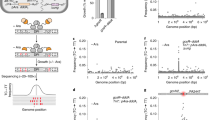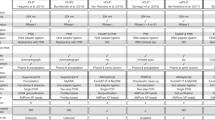Abstract
We developed a new DNA microarray-based technology, called protein binding microarrays (PBMs), that allows rapid, high-throughput characterization of the in vitro DNA binding–site sequence specificities of transcription factors in a single day. Using PBMs, we identified the DNA binding–site sequence specificities of the yeast transcription factors Abf1, Rap1 and Mig1. Comparison of these proteins' in vitro binding sites with their in vivo binding sites indicates that PBM-derived sequence specificities can accurately reflect in vivo DNA sequence specificities. In addition to previously identified targets, Abf1, Rap1 and Mig1 bound to 107, 90 and 75 putative new target intergenic regions, respectively, many of which were upstream of previously uncharacterized open reading frames. Comparative sequence analysis indicated that many of these newly identified sites are highly conserved across five sequenced sensu stricto yeast species and, therefore, are probably functional in vivo binding sites that may be used in a condition-specific manner. Similar PBM experiments should be useful in identifying new cis regulatory elements and transcriptional regulatory networks in various genomes.
This is a preview of subscription content, access via your institution
Access options
Subscribe to this journal
Receive 12 print issues and online access
$209.00 per year
only $17.42 per issue
Buy this article
- Purchase on Springer Link
- Instant access to full article PDF
Prices may be subject to local taxes which are calculated during checkout






Similar content being viewed by others
References
Schena, M., Shalon, D., Davis, R.W. & Brown, P.O. Quantitative monitoring of gene expression patterns with a complementary DNA microarray. Science 270, 467–470 (1995).
Wodicka, L., Dong, H., Mittmann, M., Ho, M.H. & Lockhart, D.J. Genome-wide expression monitoring in Saccharomyces cerevisiae. Nat. Biotechnol. 15, 1359–1367 (1997).
Ren, B. et al. Genome-wide location and function of DNA binding proteins. Science 290, 2306–2309 (2000).
Iyer, V.R. et al. Genomic binding sites of the yeast cell-cycle transcription factors SBF and MBF. Nature 409, 533–538 (2001).
Lieb, J.D., Liu, X., Botstein, D. & Brown, P.O. Promoter-specific binding of Rap1 revealed by genome-wide maps of protein-DNA association. Nat. Genet. 28, 327–334 (2001).
Lee, T. et al. Transcriptional regulatory networks in Saccharomyces cerevisiae. Science 298, 799–804 (2002).
Uetz, P. et al. A comprehensive analysis of protein-protein interactions in Saccharomyces cerevisiae. Nature 403, 623–627 (2000).
MacBeath, G. & Schreiber, S.L. Printing proteins as microarrays for high-throughput function determination. Science 289, 1760–1763 (2000).
Ito, T. et al. Toward a protein-protein interaction map of the budding yeast: A comprehensive system to examine two-hybrid interactions in all possible combinations between the yeast proteins. Proc. Natl. Acad. Sci. USA 97, 1143–1147 (2000).
Ho, Y. et al. Systematic identification of protein complexes in Saccharomyces cerevisiae by mass spectrometry. Nature 415, 180–183 (2002).
Bulyk, M.L., Huang, X., Choo, Y. & Church, G.M. Exploring the DNA-binding specificities of zinc fingers with DNA microarrays. Proc. Natl. Acad. Sci. USA 98, 7158–7163 (2001).
Linnell, J. et al. Quantitative high-throughput analysis of transcription factor binding specificities. Nucleic Acids Res. 32, e44 (2004).
Planta, R.J. Regulation of ribosome synthesis in yeast. Yeast 13, 1505–1518 (1997).
Konig, P., Giraldo, R., Chapman, L. & Rhodes, D. The crystal structure of the DNA-binding domain of yeast RAP1 in complex with telomeric DNA. Cell 85, 125–136 (1996).
Lutfiyya, L.L. et al. Characterization of three related glucose repressors and genes they regulate in Saccharomyces cerevisiae. Genetics 150, 1377–1391 (1998).
Liu, X., Brutlag, D. & Liu, J. BioProspector: discovering conserved DNA motifs in upstream regulatory regions of co-expressed genes. Pac. Symp. Biocomput. 2001, 127–138 (2001).
Hughes, J.D., Estep, P.W., Tavazoie, S. & Church, G.M. Computational identification of cis-regulatory elements associated with groups of functionally related genes in Saccharomyces cerevisiae. J. Mol. Biol. 296, 1205–1214 (2000).
Wingender, E. et al. TRANSFAC: an integrated system for gene expression regulation. Nucleic Acids Res. 28, 316–319 (2000).
Kellis, M., Patterson, N., Endrizzi, M., Birren, B. & Lander, E. Sequencing and comparison of yeast species to identify genes and regulatory elements. Nature 423, 241–254 (2003).
Cliften, P. et al. Finding functional features in Saccharomyces genomes by phylogenetic footprinting. Science 301, 71–76 (2003).
Robison, K., McGuire, A.M. & Church, G.M. A comprehensive library of DNA-binding site matrices for 55 proteins applied to the complete Escherichia coli K-12 genome. J. Mol. Biol. 284, 241–254 (1998).
Tavazoie, S., Hughes, J., Campbell, M., Cho, R. & Church, G. Systematic determination of genetic network architecture. Nat. Genet. 22, 281–285 (1999).
Drees, B.L. et al. A protein interaction map for cell polarity development. J. Cell. Biol. 154, 549–571 (2001).
Beer, M.A. & Tavazoie, S. Predicting gene expression from sequence. Cell 117, 185–198 (2004).
Tsujimoto, Y., Izawa, S. & Inoue, Y. Cooperative regulation of DOG2, encoding 2-deoxyglucose-6-phosphate phosphatase, by Snf1 kinase and the high-osmolarity glycerol-mitogen-activated protein kinase cascade in stress responses of Saccharomyces cerevisiae. J. Bacteriol. 182, 5121–5126 (2000).
Zaragoza, O., Vincent, O. & Gancedo, J.M. Regulatory elements in the FBP1 promoter respond differently to glucose-dependent signals in Saccharomyces cerevisiae. Biochem. J. 359, 193–201 (2001).
Griggs, D.W. & Johnston, M. Regulated expression of the GAL4 activator gene in yeast provides a sensitive genetic switch for glucose repression. Proc. Natl. Acad. Sci. USA 88, 8597–8601 (1991).
Grauslund, M., Lopes, J.M. & Ronnow, B. Expression of GUT1, which encodes glycerol kinase in Saccharomyces cerevisiae, is controlled by the positive regulators Adr1p, Ino2p and Ino4p and the negative regulator Opi1p in a carbon source-dependent fashion. Nucleic Acids Res. 27, 4391–4398 (1999).
Ozcan, S. & Johnston, M. Function and regulation of yeast hexose transporters. Microbiol. Mol. Biol. Rev. 63, 554–569 (1999).
Bojunga, N. & Entian, K.D. Cat8p the activator of gluconeogenic genes in Saccharomyces cerevisiae, regulates carbon source-dependent expression of NADP-dependent cytosolic isocitrate dehydrogenase (Idp2p) and lactate permease (Jen1p). Mol. Gen. Genet. 262, 869–875 (1999).
Jiang, R. & Carlson, M. The Snf1 protein kinase and its activating subunit, Snf4, interact with distinct domains of the Sip1/Sip2/Gal83 component in the kinase complex. Mol. Cell. Biol. 17, 2099–2106 (1997).
Palecek, S.P., Parikh, A.S., Huh, J.H. & Kron, S.J. Depression of Saccharomyces cerevisiae invasive growth on non-glucose carbon sources requires the Snf1 kinase. Mol. Microbiol. 45, 453–469 (2002).
Rae, F.K. et al. Analysis of complementary expression profiles following WT1 induction versus repression reveals the cholesterol/fatty acid synthetic pathways as a possible major target of WT1. Oncogene 23, 3067–3079 (2004).
Harbison, C.T. et al. Transcriptional regulatory code of a eukaryotic genome. Nature 431, 99–104 (2004).
Hartemink, A., Gifford, D., Jaakkola, T. & Young, R. Combining location and expression data for principled discovery of genetic regulatory network models. Pac. Symp. Biocomput. 2002, 437–449 (2002).
Doi, N. et al. Novel fluorescence labeling and high-throughput assay technologies for in vitro analysis of protein interactions. Genome Res. 12, 487–492 (2002).
Man, T.K. & Stormo, G.D. Non-independence of Mnt repressor-operator interaction determined by a new quantitative multiple fluorescence relative affinity (QuMFRA) assay. Nucleic Acids Res. 29, 2471–2478 (2001).
Bulyk, M., Johnson, P. & Church, G. Nucleotides of transcription factor binding sites exert interdependent effects on the binding affinities of transcription factors. Nucleic Acids Res. 30, 1255–1261 (2002).
Udalova, I., Mott, R., Field, D. & Kwiatkowski, D. Quantitative prediction of NF-kappa B DNA-protein interactions. Proc. Natl. Acad. Sci. USA 99, 8167–8172 (2002).
Desjarlais, J.R. & Berg, J.M. Toward rules relating zinc finger protein sequences and DNA binding site preferences. Proc. Natl. Acad. Sci. USA 89, 7345–7349 (1992).
Philippakis, A., He, F. & Bulyk, M. ModuleFinder: a tool for computational discovery of cis regulatory modules. Pac. Symp. Biocomput. (in the press).
Zhu, H. et al. Global analysis of protein activities using proteome chips. Science 26, 2101–2105 (2001).
Dudley, A., Aach, J., Steffen, M. & Church, G. Measuring absolute expression with microarrays with a calibrated reference sample and an extended signal intensity range. Proc. Natl. Acad. Sci. USA 99, 7554–7559 (2002).
Cleveland, W. & Devlin, S. Locally weighted regression: An approach to regression analysis by local fitting. J. Am. Stat. Assoc. 83, 596–610 (1988).
Sokal, R. & Rohlf, R. Biometry: The Principles and Practice of Statistics in Biological Research (W. H. Freeman and Company, New York, 1995).
Liu, X., Brutlag, D. & Liu, J. An algorithm for finding protein–DNA binding sites with applications to chromatin-immunoprecipitation microarray experiments. Nat. Biotechnol. 20, 835–839 (2002).
Robinson, M., Grigull, J., Mohammad, N. & Hughes, T. FunSpec: a web-based cluster interpreter for yeast. BMC Bioinformatics 3, 35 (2002).
Stuart, J.M., Segal, E., Koller, D. & Kim, S.K. A gene-coexpression network for global discovery of conserved genetic modules. Science 302, 249–255 (2003).
Schneider, T.D. & Stephens, R.M. Sequence logos: a new way to display consensus sequences. Nucleic Acids Res. 18, 6097–6100 (1990).
Acknowledgements
We thank T. Volkert and T. Lee for synthesis of the whole-genome yeast intergenic microarrays, B. Huber for assistance with motif searches, L. Campbell and M. Blayney for technical assistance and M. Chou and A. Philippakis for discussion. This work was supported by National Institutes of Health grants from the National Human Genome Research Institute to M.L.B. and to R.Y. and from the National Institute of General Medical Sciences to M.S. M.L.B. was also supported by a Pharmaceutical Research and Manufacturers of America Foundation Informatics Research Starter Grant and an HST Taplin Award. S.M. was supported in part by the MIT Class of 1973 Undergraduate Research Opportunities Program Fund and an MIT Bioengineering Undergraduate Research Award. M.F.B. was supported in part by a Graduate Research Fellowship from the National Science Foundation.
Author information
Authors and Affiliations
Corresponding author
Ethics declarations
Competing interests
The authors declare no competing financial interests.
Supplementary information
Supplementary Fig. 1
DNA microarray bound by CBP-FLAG-Rpn4. (PDF 103 kb)
Supplementary Fig. 2
Negative control PBMs. (PDF 103 kb)
Supplementary Fig. 3
Reproducibility of PBM data. (PDF 369 kb)
Supplementary Fig. 4
Effect of less stringent P-value thresholds on the number of spots identified as bound. (PDF 23 kb)
Supplementary Fig. 5
Binding site motifs for PBM data passing less stringent P-value thresholds. (PDF 71 kb)
Supplementary Fig. 6
Comparison of bound intergenic regions derived from PBM versus ChIP-chip data at various P-value thresholds. (PDF 279 kb)
Rights and permissions
About this article
Cite this article
Mukherjee, S., Berger, M., Jona, G. et al. Rapid analysis of the DNA-binding specificities of transcription factors with DNA microarrays. Nat Genet 36, 1331–1339 (2004). https://doi.org/10.1038/ng1473
Received:
Accepted:
Published:
Issue Date:
DOI: https://doi.org/10.1038/ng1473
This article is cited by
-
KaScape: a sequencing-based method for global characterization of protein‒DNA binding affinity
Scientific Reports (2023)
-
MD-SVM: a novel SVM-based algorithm for the motif discovery of transcription factor binding sites
BMC Bioinformatics (2019)
-
Synthetic Promoters: Designing the cis Regulatory Modules for Controlled Gene Expression
Molecular Biotechnology (2018)
-
CIBZ Regulates Mesodermal and Cardiac Differentiation of by Suppressing T and Mesp1 Expression in Mouse Embryonic Stem Cells
Scientific Reports (2016)
-
Learning Quantitative Sequence–Function Relationships from Massively Parallel Experiments
Journal of Statistical Physics (2016)



